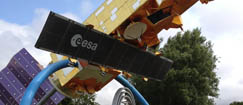Sunday 25 May 2014
Space Batteries – Success!

Following 2 years and £1M of work, NNL recently presented the final results of our current ‘Space Batteries’ project to the European Space Agency (ESA) in the Netherlands. The purpose of the work was to determine the technical feasibility and cost of separating americium from plutonium so that it can potentially be used to power space batteries.
NNL split this work into two phases. The first phase developed the chemical flowsheet required to process plutonium to produce americium, followed by the design and costing of the plant that could deliver this on the scale required by ESA.
The second phase of the project was to prove the process using NNL’s state of the art facilities at Central Laboratory, Cumbria. A small quantity of plutonium was imported from the stocks held in storage at Sellafield on behalf of the UK Government.
Americium was successfully separated using the flowsheet developed in the first phase of work. Analysis of the process and the final americium product confirmed that the flowsheet performed even better than designed, allowing a reduced cost estimate for the final plant to be produced.
Alongside these two phases of work, studies were also completed to examine the security, safety and environmental impacts expected for the final plant. In addition extensive senior stakeholder dialogue was undertaken to ensure key stakeholders were aware of the work and supported further development.
Success
The success of the project has led ESA to declare their intention to award further work to NNL. This is expected to be worth around €2M and last a further 2 years, starting later in 2013. This next phase of work will look to further develop the flowsheet, significantly increasing the quantity of americium separated by NNL, and develop the process to produce pellets of americium that could be used in the final space batteries.
Managing Director, Paul Howarth, commented:
“I’m pleased that we were able to exceed ESA’s expectations by proving the technical feasibility of using americium in space batteries and being able to show potential cost reductions in doing so. This is another example of NNL’s combination of people, facilities and expertise coming together to deliver a great outcome for one of our customers.”
